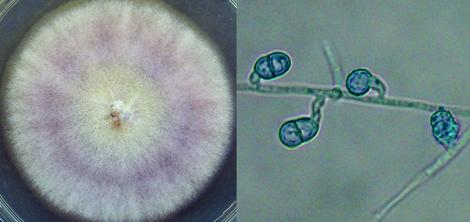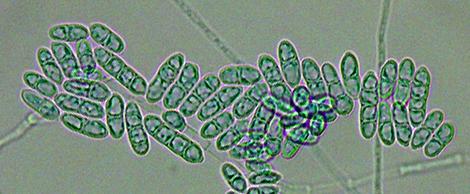Cylindrocarpon
The genus contains 35 species, mostly from soil and as an occasional human and animal pathogen.
Cylindrocarpon differs from Fusarium by lacking an asymmetrical foot-cell on the macroconidia.

Culture and chlamydospores of Cylindrocarpon spp.
RG-2 organism (if isolated from humans).
Morphological description:
Colonies are fast growing, hyaline or bright-coloured, suede-like or woolly. Sporodochia may occasionally be present. Conidiophores consist of simple or repeatedly verticillate phialides, arranged in brush-like structures. Phialides are cylindrical to subulate, with small collarettes producing hyaline, smooth-walled conidia, arranged in slimy masses. Two types of conidia may be produced: (1) macroconidia which are one to several septate, hyaline, straight or curved, cylindrical to fusiform, with a rounded apex and flat base; and (2) microconidia which are one-celled, and usually clearly distinct from the macroconidia. Chlamydospores may be present or absent, hyaline to brown, spherical, formed singly, in chains or in clumps, intercalary or terminal.
References:
Booth (1966), Domsch et al. (1980), de Hoog et al. (2000, 2015).

Macroconidia of Cylindrocarpon spp
